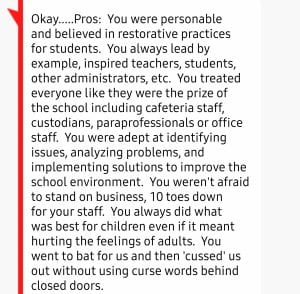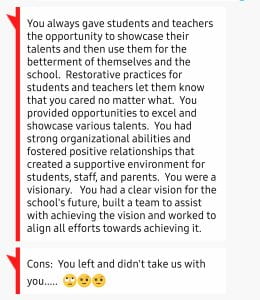I was supposed to drop this post in February, but my travel schedule was super hectic, and I figured it would happen when it was supposed to. Hence…here we are. Ideally, I think I’ll start trying to release a post every Thursday. Thursday Thoughts seems to have a ring to it, but we’ll see if I’m able to keep it consistent. This post was going to be coupled with a video (which I’ve dropped over on my IG page, @thatmancanteach) that I recorded when I was in Texas at the Starbucks. If you remember, I’d discussed how the manager rallied the team together to celebrate the birthday of one of the employees. The young lady cried and said that what they did for her meant the world, and she concluded by saying it was the best place she’d ever worked. To her co-workers, they may have just thought it was a small token to show her that they remembered her birthday, but to her, it was a huge gesture that said, “We see you; we appreciate you; we love you.” The leadership lesson that I took from it rings true, especially at this moment where educators are deciding on whether or not they will return next school year. We know that there’s a significant teacher shortage, so principals I have a question for you. What have you done to make your teachers feel seen, appreciated, and loved? What have you done to make your other principal friends (because we all need them) feel the same way? Don’t overlook the value those relationships can bring to you and those individuals you need on a daily basis.
The questions above have had me reflecting, even in my current role. It’s amazing because I’ve been coaching and working to help others turn around their schools for 2 years now, as of April 5th! Lately, I’ve been running into a lot of my old colleagues, people I taught with and teachers that worked for me when I was a principal and an AP. The common question that I oftentimes get is, “Don’t you want to be a principal again? Can you show other leaders how to do what you used to do?” The short answer is yes and yes, if I’m being honest, but there are so many places and leaders that need connections to outside partners with my skillset, which makes me value what I do now even more. It’s important as well.
Just recently, I sent out a text to some of the old teachers and leaders in the building where I worked and asked them what I did well. I also asked them what I could improve on when I was in the principal’s seat. One of the things I know for sure is that I can’t make other people me, and I also know that I didn’t always do the job to it’s full capacity; however, I wanted to see if they could name some of the things that stuck out in my mind as core leader and principal characteristics.
The screenshots above were from one of the members of my leadership team. There were others that named almost the exact same characteristics, which confirmed my thoughts and approach. One of the real cons I saw from someone named that I could have delegated more to the leaders I had directly under me. The teacher who shared named that I could have built more space for individuals to grow by taking off the training wheels and letting those leaders learn through the struggles more, and I definitely agree, even to this day.
In the principal’s seat, I ALWAYS wanted to put kids first, but I also wanted to make sure the teachers that worked in the building understood why I made the decisions I made. I also had a good team around me that I trusted and had honest, open conversations with consistently, and they would tell me when I needed to push or when I needed to pull back to give people breathing room. Ms. McCann and Dr. Murrah, instructional coaches at the time, were good at saying, “Doc, that’s too much for teachers right now. What’s the one thing we want to get done because if we give them all of this, they’ll shut down.” I appreciated that. And one of the most important things I was able to do was be my authentic self in the seat. I told them about my family, what made me happy, what made me unhappy, etc., and they did the same for me. I CARED for the people in the building, and that showed up in the most important times. That care has to be reciprocated because when it’s in play, kids are the beneficiaries of it, which is shown in an awesome climate, culture, and solid instruction.
I bring this story up because we’re at the point in the year where we’re making plans to close out this year and plan for the upcoming school year. It’s probably one of the most difficult times to lead a school because there are state testing plans that are being developed, closing out of old budgets, creations of new budgets, etc. IT IS A LOT TO MANAGE!!! But at the core of all of it is and should always be kids. How can we make the next year better for the students that walk through the doors of the school? What did we do well this year? What did we not do so well? Who is aligned with the values of the school and who isn’t? The last question is a tough one, but it’s important. Spoiled apples can cause the others to spoil quicker if they’re not removed from the bag. Take that for what it’s worth.
When I was in Arizona on a coaching assignment for principals, we saw data that showed that there were significant vacancies throughout the state, but there were an excess of 2,000 people who were walking around with valid teaching certificates that were not putting it to use. Why? That was the question that we kept asking ourselves. As I’ve traveled over the nation, I’ve noted that the school I entered as a teacher in 2007 is no longer the same school in 2024. It takes teams of people to make school work for kids, and it take strong leadership teams to make sure that schools work for teachers. As I prepare to close out this year myself as a teacher and leadership coach, I find myself reflecting on how we can not only get more at bats for teachers to be successful, but also how we can get more at bats for principals to really analyze the strengths and growth areas of their buildings. Sometimes, this is hard because naming ourselves as the root of the problem can be a hard pill to swallow. But again, getting that pill down can be what causes us to be successful, or it can be what keeps us in the same, stagnant place. And kids can’t afford us to be stagnant.
Being a leader isn’t about holding a title. Any professional boxer can get a title if he or she works hard enough, but sustaining and keeping that title while having excellent results is the real work. That’s the hard part. So, as leaders and educators, let’s start reflecting on what we’ve done well and what we need to do better so we can build safe spaces and communities for our children and teachers. Let’s get out of our own way and name exactly what we want to do and who we need on the team to help us get there. Cailtyn Clark and Angel Reese are some superb basketball players who have worked to change people’s perceptions about women’s basketball, but they both have excellent players around them that keep the team afloat by setting goals and by playing their parts individually and collectively. Can you say the same for your school? If not, it’s time to roll up your sleeves or take off that blazer to that nice suit and get ready to get in the weeds with everyone else. There’s work to be done! No matter where you are located in the nation or world- those kids deserve it! Let’s make it happen.
Be accountable. Be committed.
Dr. G.

